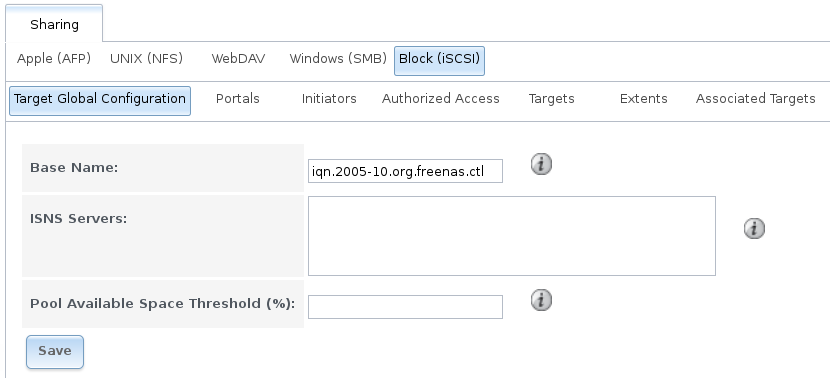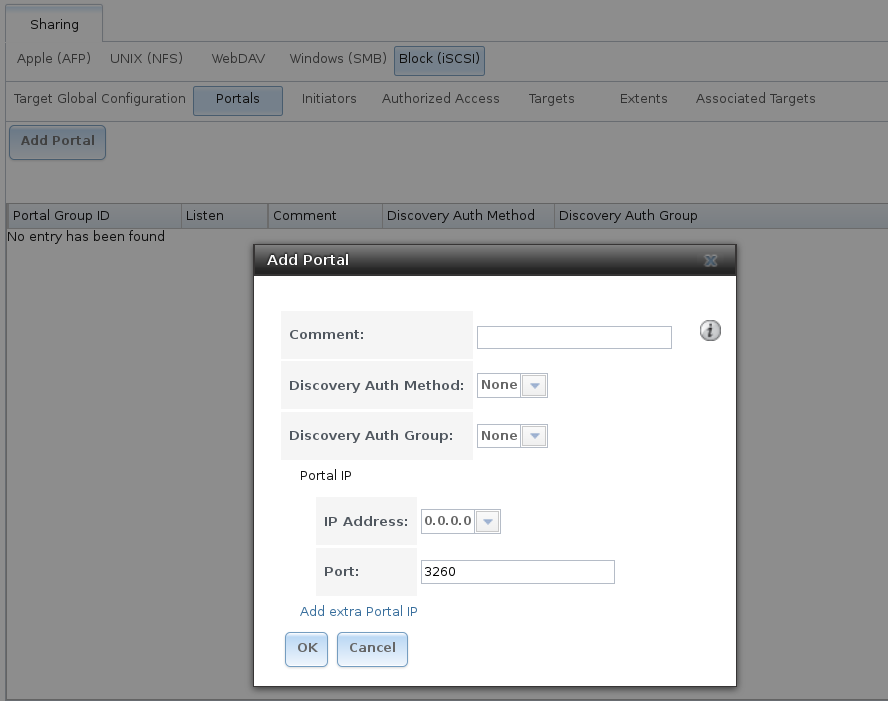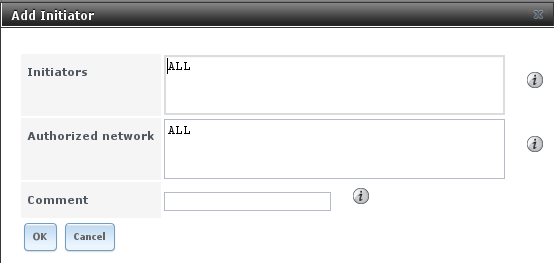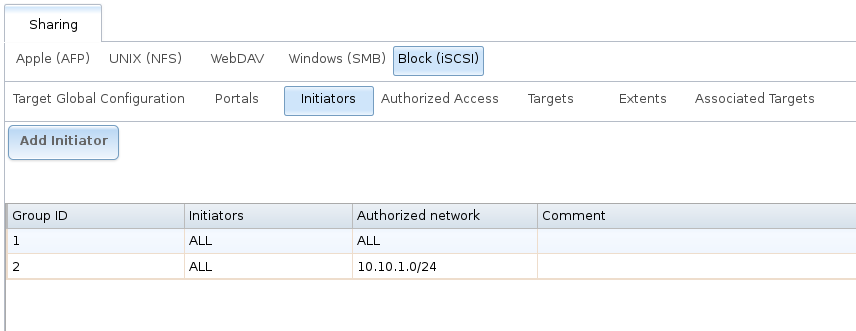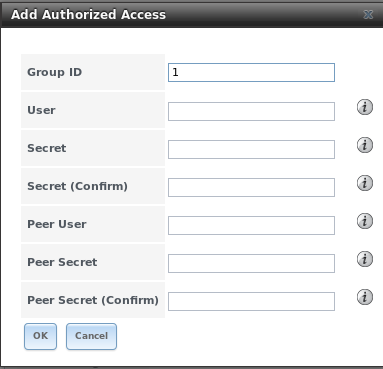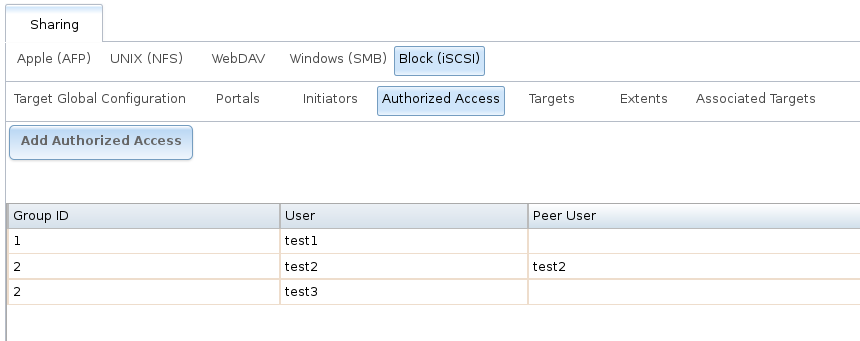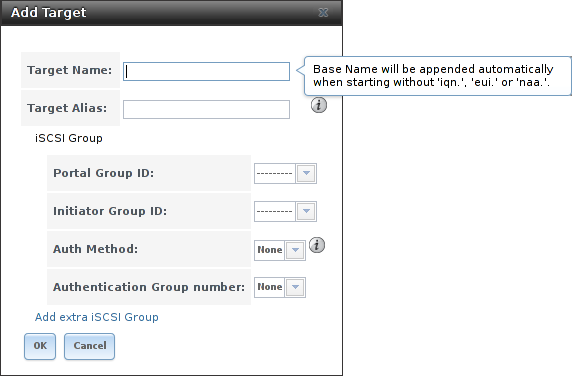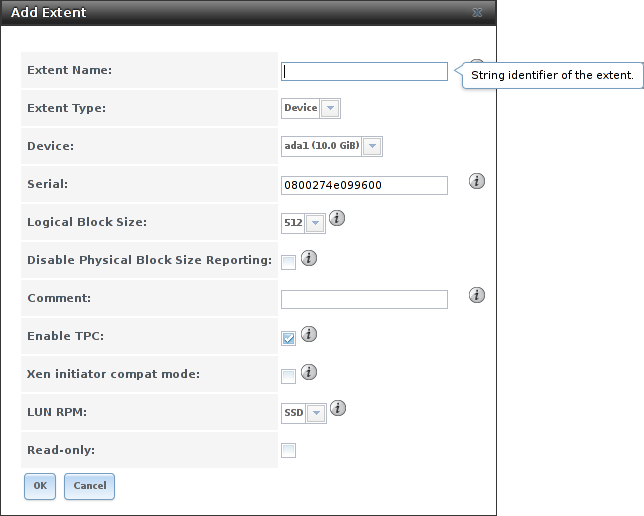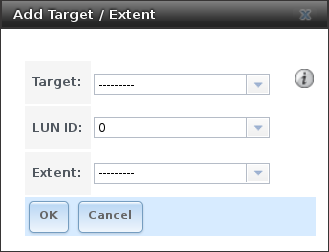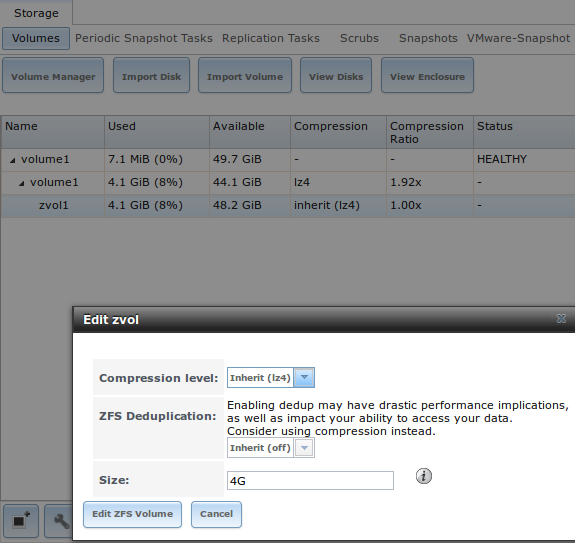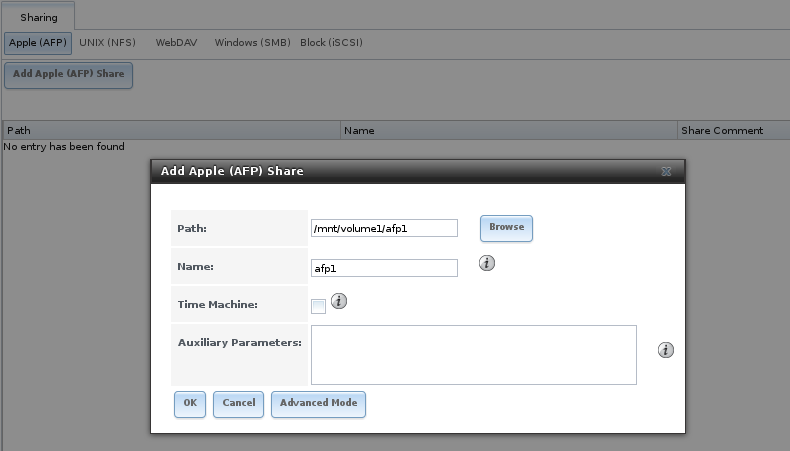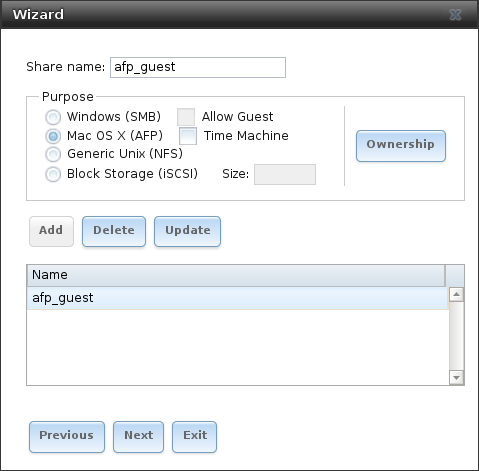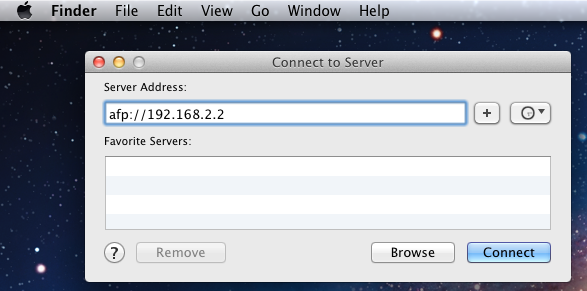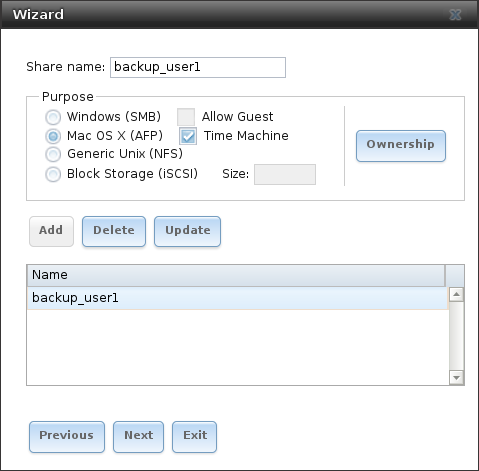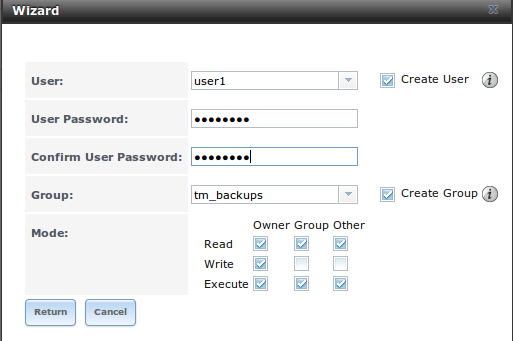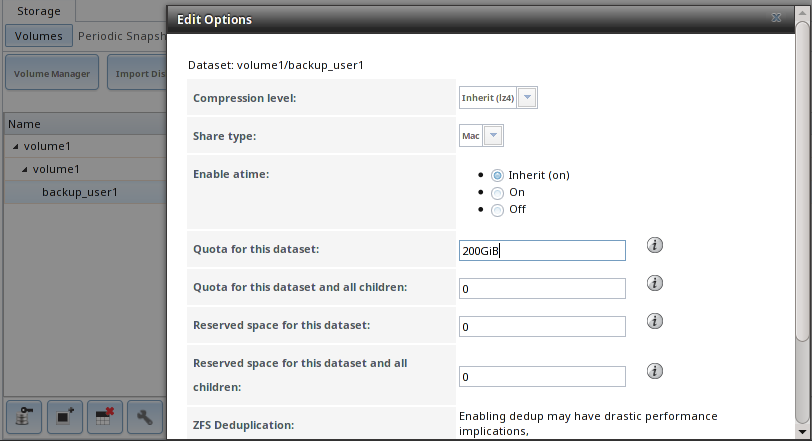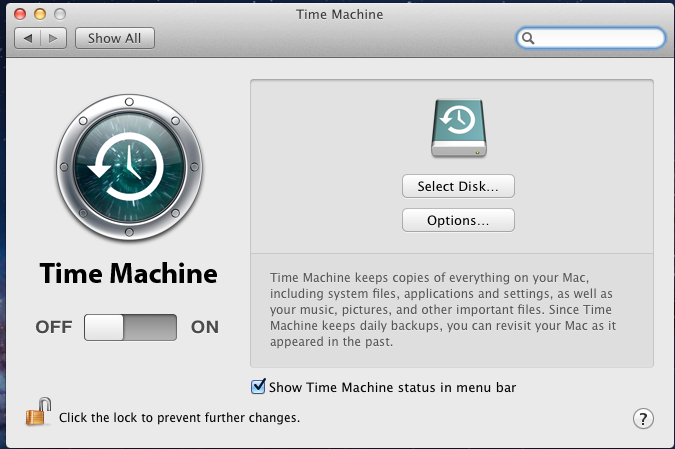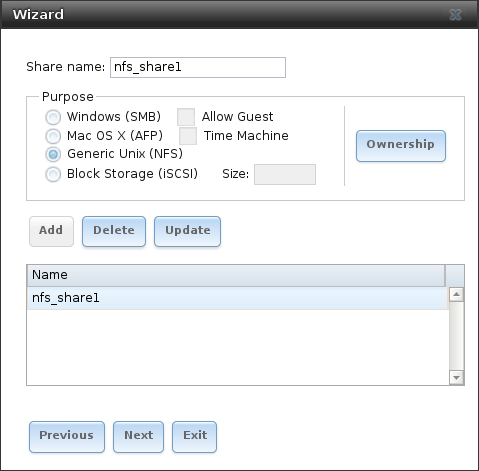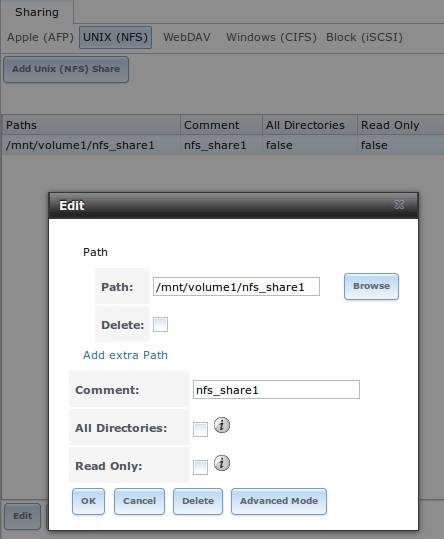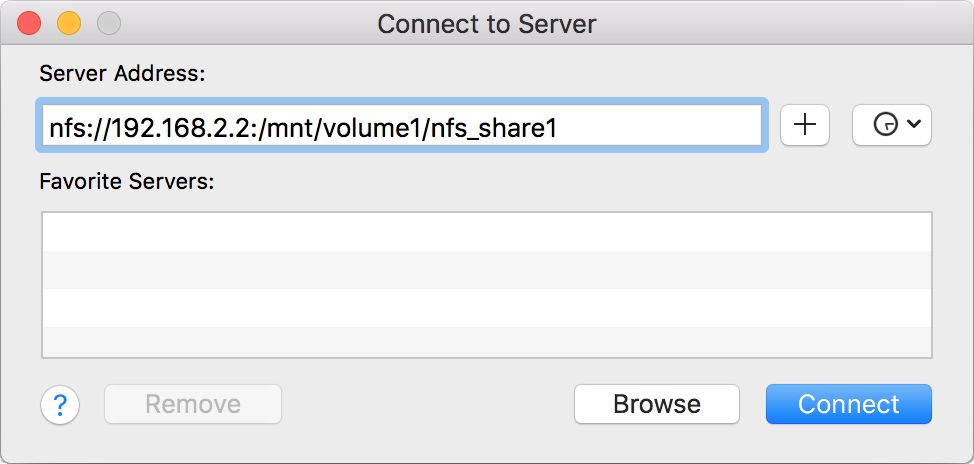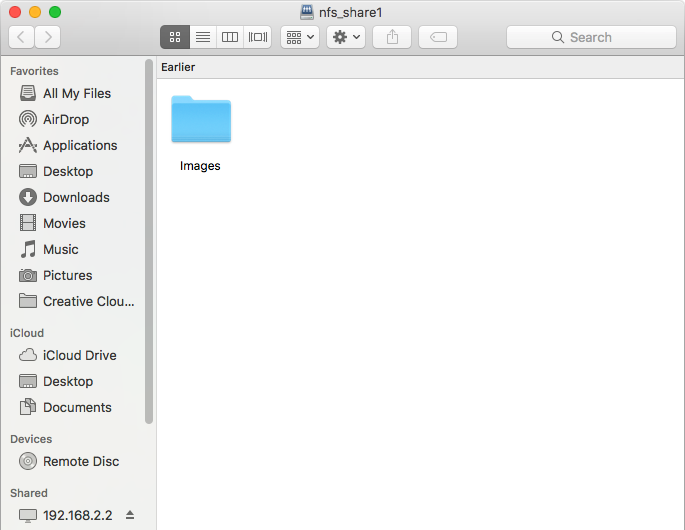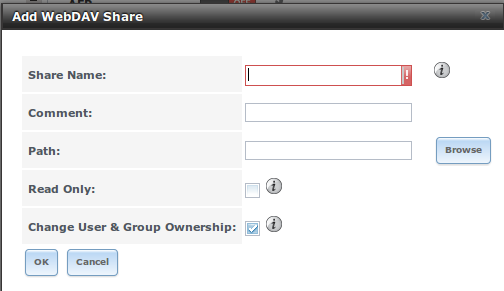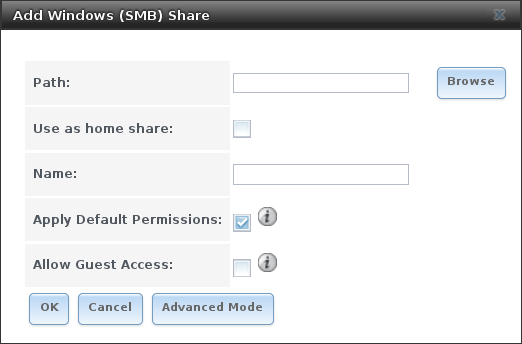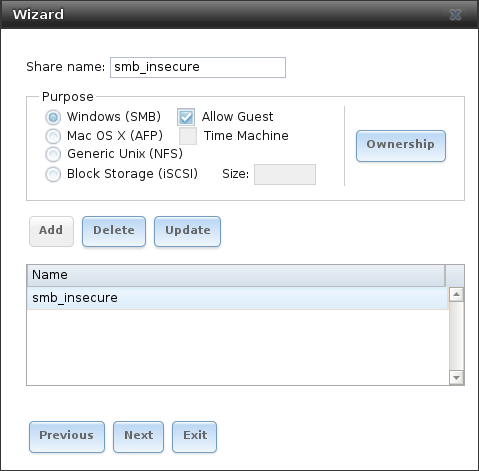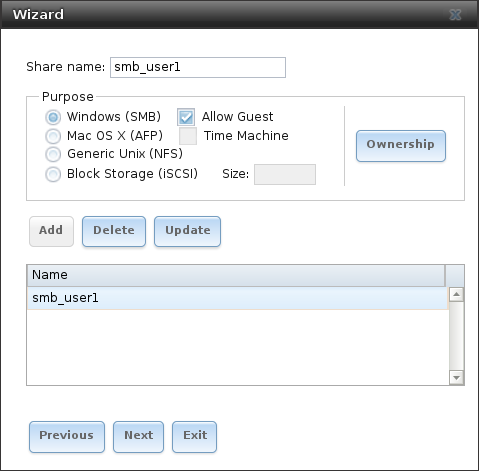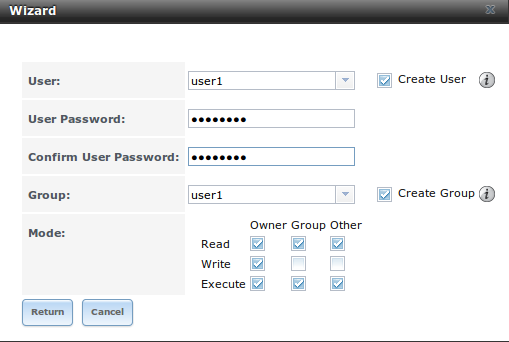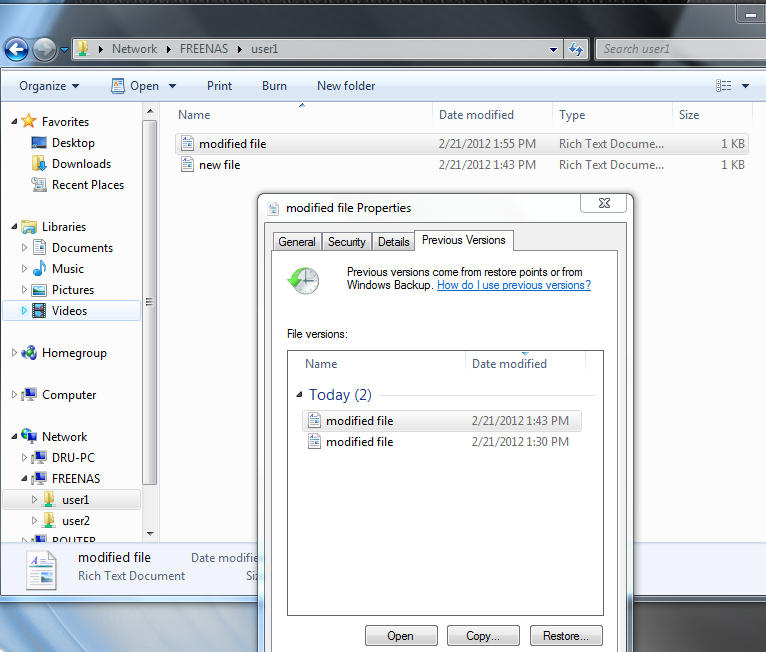When data security is a concern and the network users are familiar
with SSH command line utilities or
WinSCP,
consider using the SSH service instead of a share. It is slower
than unencrypted FTP due to the encryption overhead, but the data
passing through the network is encrypted.
This section demonstrates configuration and fine-tuning of AFP, NFS,
SMB, WebDAV, and iSCSI shares. FTP and SSH configurations are
described in Services.
10.1. Apple (AFP) Shares
FreeNAS® uses the
Netatalk
AFP server to share data with Apple systems. This section describes
the configuration screen for fine-tuning AFP shares created using the
Wizard. It then provides configuration examples for using the
Wizard to create a guest share, configuring Time Machine to
back up to a dataset on the FreeNAS® system, and for connecting to the
share from a macOS client.
To view the AFP share created by the Wizard, click
and highlight the name of the share. Click its Edit button
to see the configuration options shown in
Figure 10.1.1.
The values showing for these options will vary, depending upon the
information given when the share was created.
Note
Table 10.1.1
summarizes the options available to fine-tune an AFP share. Leaving these
options at the default settings is recommended as changing
them can cause unexpected behavior. Most settings are only
available with Advanced Mode. Do not change an
advanced option without fully understanding the function of that
option. Refer to
Setting up Netatalk
for a more detailed explanation of these options.
Table 10.1.1 AFP Share Configuration Options
| Setting |
Value |
Advanced
Mode |
Description |
|---|
| Path |
browse button |
|
Browse to the volume/dataset to share. Do not nest additional volumes, datasets, or symbolic
links beneath this path because Netatalk does not fully support that. |
| Use as home share |
checkbox |
|
Set to allow the share to host user home directories. Only one share can be used as the home share. |
| Name |
string |
|
Enter the volume name that appears in in macOS after selecting in
the Finder menu. Limited to 27 characters and cannot contain a period. |
| Share Comment |
string |
✓ |
Enter an optional comment. |
| Allow List |
string |
✓ |
Comma-delimited list of allowed users and/or groups where groupname begins with a @. Note
that adding an entry will deny any user/group that is not specified. |
| Deny List |
string |
✓ |
Comma-delimited list of denied users and/or groups where groupname begins with a @. Note
that adding an entry will allow all users/groups that are not specified. |
| Read-only Access |
string |
✓ |
Comma-delimited list of users and/or groups who only have read access where groupname begins with a
@. |
| Read-write Access |
string |
✓ |
Comma-delimited list of users and/or groups who have read and write access where groupname begins with a
@. |
| Time Machine |
checkbox |
|
Set to advertise FreeNAS® as a Time Machine disk so it can be found by Macs. Setting multiple shares
for Time Machine use is not recommended. When multiple Macs share the same pool,
low diskspace issues and intermittently failed backups can occur. |
| Zero Device Numbers |
checkbox |
✓ |
Enable when the device number is not constant across a reboot. |
| No Stat |
checkbox |
✓ |
If enabled, AFP does not stat the volume path when enumerating the volumes list. Useful for
automounting or volumes created by a preexec script. |
| AFP3 UNIX Privs |
checkbox |
✓ |
Set to enable Unix privileges supported by OSX 10.5 and higher. Do not enable this if the network contains
macOS 10.4 clients or lower as they do not support this feature. |
| Default file permission |
checkboxes |
✓ |
Only works with Unix ACLs. New files created on the share are set with the selected permissions. |
| Default directory permission |
checkboxes |
✓ |
Only works with Unix ACLs. New directories created on the share are set with the selected permissions. |
| Default umask |
integer |
✓ |
Umask is used for newly created files. Default is 000 (anyone can read, write, and execute). |
| Hosts Allow |
string |
✓ |
Enter a list of allowed hostnames or IP addresses. Separate entries with a comma, space, or tab. |
| Hosts Deny |
string |
✓ |
Enter a list of denied hostnames or IP addresses. Separate entries with a comma, space, or tab. |
| Auxiliary Parameters |
string |
|
Additional afp.conf parameters
not covered by other option fields. |
10.1.1. Creating AFP Guest Shares
AFP supports guest logins, meaning that macOS users can access the
AFP share without requiring their user accounts to first be created on
or imported into the FreeNAS® system.
Note
When a guest share is created along with a share that
requires authentication, AFP only maps users who log in as guest
to the guest share. If a user logs in to the share that requires
authentication, permissions on the guest share can prevent that
user from writing to the guest share. The only way to allow both
guest and authenticated users to write to a guest share is to set
the permissions on the guest share to 777 or to add the
authenticated users to a guest group and set the permissions to
77x.
Before creating a guest share, go to
and make sure that the Guest Access option is enabled.
To create the AFP guest share, click Wizard, then click
the Next button twice to display the screen shown in
Figure 10.1.2.
Complete these fields in this screen:
- Share name: enter a name for the share that is identifiable but
less than 27 characters long. This name cannot contain a period. In
this example, the share is named afp_guest.
- Click the button for Mac OS X (AFP).
- Click the Ownership button. Click the drop-down
User menu and select nobody. Click the
Return button to return to the previous screen.
- Click the Add button.
The share is not created until the button is clicked.
Clicking the Add button adds an entry to the
Name frame with the name that was entered in
Share name.
Click the Next button twice, then the Confirm
button to create the share. The Wizard automatically creates a dataset
for the share that contains the correct default permissions and starts
the AFP service so the share is immediately available. The new share
is also added as an entry to
.
macOS users can connect to the guest AFP share by navigating to
. In the example shown in
Figure 10.1.3,
the user entered afp:// followed by the IP address of the
FreeNAS® system.
Click the Connect button. Once connected, Finder opens
automatically. The name of the AFP share is displayed in the SHARED
section in the left frame and the contents of any data saved in the
share is displayed in the right frame.
To disconnect from the volume, click the eject button in
the Shared sidebar.
10.1.2. Creating Authenticated and Time Machine Shares
macOS includes the Time Machine application which can be used to
schedule automatic backups. In this configuration example, a Time
Machine user will be configured to backup to an AFP share on a
FreeNAS® system. Creating a separate Time Machine
share for each user that will be using Time Machine to backup their
macOS system to FreeNAS® is recommended. The process for creating
an authenticated share for a user is the same as creating a
Time Machine share for that user.
To use the Wizard to create an authenticated or Time Machine share,
enter the following information, as seen in the example in
Figure 10.1.4.
- Share name: enter a name for the share that is identifiable but
less than 27 characters long. The name cannot contain a period. In
this example, the share is named backup_user1.
- Click the button for Mac OS X (AFP) and enable the
for Time Machine option.
- Click the Ownership button. If the user already exists
on the FreeNAS® system, click the drop-down User menu to
select their user account. If the user does not yet exist on the
FreeNAS® system, type their name into the User field and
enable the Create User option. If the user will be a
member of a group that already exists on the FreeNAS® system, click
the drop-down Group menu to select the group name. To
create a new group to be used by Time Machine users, enter the name
in the Group field and set the
Create Group option. Otherwise, enter the same name
as the user. In the example shown in
Figure 10.1.5,
both a new user1 user and a new tm_backups group will be
created. Since a new user is being created, this screen prompts for
the user password to be used when accessing the share. It also
provides an opportunity to change the default permissions on the
share. When finished, click Return to return to the
screen shown in
Figure 10.1.4.
- Click the Add button.
Remember to do this or the share will not be created.
Clicking the Add button adds an entry to the
Name frame with the name that was entered in
Share name.
To configure multiple authenticated or Time Machine shares, repeat for
each user, giving each user their own Share name and
Ownership. When finished, click the Next
button twice, then the Confirm button to create the
shares. The Wizard automatically creates a dataset for each share with
the correct ownership and starts the AFP service so the shares are
immediately available. The new shares will appear in
.
At this point, it may be desirable to configure a quota for each Time
Machine share, to restrict backups from using all of the available
space on the FreeNAS® system. The first time Time Machine makes a
backup, it will create a full backup after waiting two minutes. It
will then create a one hour incremental backup for the next 24 hours,
and then one backup each day, each week and each month.
Since the oldest backups are deleted when a Time Machine share
becomes full, make sure that the quota size is sufficient to hold the
desired number of backups.
Note that a default installation of macOS is ~21 GB in size.
To configure a quota, go to
and highlight the entry for the share. In the example shown in
Figure 10.1.6,
the Time Machine share name is backup_user1. Click the
Edit Options button for the share, then
Advanced Mode. Enter a value in the
Quota for this dataset field, then click
Edit Dataset to save the change. In this example, the
Time Machine share is restricted to 200 GB.
To configure Time Machine on the macOS client, go to
which opens the screen shown in
Figure 10.1.7.
Click ON and a pop-up menu shows the FreeNAS® system as a
backup option. In this example, it is listed as
backup_user1 on “freenas”. Highlight the FreeNAS® system and click
Use Backup Disk. A connection bar opens and prompts for
the user account’s password–in this example, the password that was
set for the user1 account.
If Time Machine could not complete the backup. The
backup disk image could not be created (error 45) is shown when
backing up to the FreeNAS® system, a sparsebundle
image must be created using
these instructions.
If Time Machine completed a verification of
your backups. To improve reliability, Time Machine must create a new
backup for you. is shown, follow the instructions in
this post
to avoid making another backup or losing past backups.
10.2. Unix (NFS) Shares
FreeNAS® supports sharing over the Network File System (NFS). Clients
use the mount command to mount the share. Once mounted, the
NFS share appears as just another directory on the client system. Some
Linux distros require the installation of additional software in order
to mount an NFS share. On Windows systems, enable Services for NFS in
the Ultimate or Enterprise editions or install an NFS client
application.
Note
For performance reasons, iSCSI is preferred to NFS shares
when FreeNAS® is installed on ESXi. When considering creating NFS
shares on ESXi, read through the performance analysis at
Running ZFS over NFS as a VMware Store.
To create an NFS share using the Wizard, click the
Next button twice to display the screen shown in
Figure 10.2.1.
Enter a Share name. Spaces are not allowed in these names.
Click the button for Generic Unix (NFS), then click
Add so the share name appears in the Name
frame. When finished, click the Next button twice, then
the Confirm button to create the share. Creating an NFS
share using the wizard automatically creates a new dataset for the
share, starts the services required for NFS, and adds an entry in
.
Depending on the requirements, the IP addresses that are allowed to
access the NFS share can be restricted, or the permissions adjusted.
NFS shares are edited by clicking
,
highlighting the entry for the share, and clicking the
Edit button. In the example shown in
Figure 10.2.2,
the configuration screen is open for the nfs_share1 share.
Table 10.2.1
summarizes the available configuration options in this screen. Some
settings are only available by clicking the Advanced Mode
button.
Table 10.2.1 NFS Share Options
| Setting |
Value |
Advanced
Mode |
Description |
|---|
| Path |
browse button |
|
Browse to the volume or dataset to be shared. Click Add extra path to select
multiple paths. |
| Comment |
string |
|
Set the share name. If left empty, share name is the list of selected Path entries. |
| Authorized networks |
string |
✓ |
Space-delimited list of allowed networks in network/mask CIDR notation, like 1.2.3.0/24.
Leave empty to allow all. |
| Authorized IP
addresses or hosts |
string |
✓ |
Space-delimited list of allowed IP addresses or hostnames. Leave empty to allow all. |
| All directories |
checkbox |
|
Set to allow the client to mount any subdirectory within the Path. |
| Read only |
checkbox |
|
Set to prohibit writing to the share. |
| Quiet |
checkbox |
✓ |
Set to inhibit some syslog diagnostics to avoid some error messages. See
exports(5) for examples. |
| Maproot User |
drop-down menu |
✓ |
When a user is selected, the root user is limited to the permissions of that user. |
| Maproot Group |
drop-down menu |
✓ |
When a group is selected, the root user is also limited to the permissions of that group. |
| Mapall User |
drop-down menu |
✓ |
All clients use the permissions of the specified user. |
| Mapall Group |
drop-down menu |
✓ |
All clients use the permissions of the specified group. |
| Security |
selection |
✓ |
Only appears if Enable NFSv4 is enabled in
. Choices are sys or these Kerberos options:
krb5 (authentication only),
krb5i (authentication and integrity), or
krb5p (authentication and privacy). If multiple security mechanisms are added to the
Selected column using the arrows, use the Up or Down buttons
to list in order of preference. |
When creating NFS shares, keep these points in mind:
- Clients will specify the Path when mounting the share.
- The Maproot and Mapall options are
exclusive, meaning only one can be used as the GUI does not allow
both. The Mapall options supersede the
Maproot options. To restrict only the root user’s
permissions, set the Maproot option. To restrict
permissions of all users, set the Mapall options.
- Each volume or dataset is considered to be its own filesystem and
NFS is not able to cross filesystem boundaries.
- The network must be unique per share and per filesystem or
directory. Since
/etc/exports does not act like an ACL, the
rule to apply is undefined among overlapping networks or when using
the same share with multiple hosts.
- The All directories option can only be used once per
share per filesystem.
To better understand these restrictions, consider a scenario where
there are:
- two networks, 10.0.0.0/8 and 20.0.0.0/8
- a ZFS volume named
volume1 with 2 datasets named
dataset1 and dataset2
dataset1 contains a directory named directory1
Because of restriction #3, an error is shown when trying to create one
NFS share like this:
- Authorized networks set to 10.0.0.0/8 20.0.0.0/8
- Path set to
/mnt/volume1/dataset1 and
/mnt/volume1/dataset1/directory1
Instead, set a Path of /mnt/volume1/dataset1 and
check the All directories box.
That directory could also be restricted to one of the networks by
creating two shares instead:
First NFS share:
- Authorized networks set to 10.0.0.0/8
- Path set to
/mnt/volume1/dataset1
Second NFS share:
- Authorized networks set to 20.0.0.0/8
- Path set to
/mnt/volume1/dataset1/directory1
Note that this requires the creation of two shares. It cannot be
done with only one share.
10.2.1. Example Configuration
By default, the Mapall fields are not set. This means
that when a user connects to the NFS share, the user has the
permissions associated with their user account. This is a security
risk if a user is able to connect as root as they will have complete
access to the share.
A better option is to do this:
- Specify the built-in nobody account to be used for NFS access.
- In the Change Permissions screen of the volume/dataset
that is being shared, change the owner and group to nobody and
set the permissions according to the desired requirements.
- Select nobody in the Mapall User and
Mapall Group drop-down menus for the share in
.
With this configuration, it does not matter which user account
connects to the NFS share, as it will be mapped to the nobody user
account and will only have the permissions that were specified on the
volume/dataset. For example, even if the root user is able to
connect, it will not gain root access to the share.
10.2.2. Connecting to the Share
The following examples share this configuration:
- The FreeNAS® system is at IP address 192.168.2.2.
- A dataset named
/mnt/volume1/nfs_share1 is created and the
permissions set to the nobody user account and the nobody
group.
- An NFS share is created with these attributes:
- Path:
/mnt/volume1/nfs_share1
- Authorized Networks: 192.168.2.0/24
- All Directories option is enabled
- MapAll User is set to nobody
- MapAll Group is set to nobody
10.2.2.1. From BSD or Linux
NFS shares are mounted on BSD or Linux clients with this command
executed as the superuser (root) or with sudo:
mount -t nfs 192.168.2.2:/mnt/volume1/nfs_share1 /mnt
- -t nfs specifies the filesystem type of the share
- 192.168.2.2 is the IP address of the FreeNAS® system
- /mnt/volume/nfs_share1 is the name of the directory to be
shared, a dataset in this case
- /mnt is the mountpoint on the client system. This must be an
existing, empty directory. The data in the NFS share appears
in this directory on the client computer.
A successful mounting of the share returns to the command prompt
without any status or error messages.
Note
If this command fails on a Linux system, make sure that the
nfs-utils
package is installed.
This configuration allows users on the client system to copy files to
and from /mnt (the mount point). All files are owned by
nobody:nobody. Changes to any files or directories in /mnt
are written to the FreeNAS® system’s /mnt/volume1/nfs_share1
dataset.
Settings cannot be changed on the NFS share if it is mounted on any
client computers. The umount command is used to unmount
the share on BSD and Linux clients. Run it as the superuser or with
sudo on each client computer:
10.2.2.2. From Microsoft
Windows NFS client support varies with versions and releases. For
best results, use Windows (SMB) Shares.
10.2.2.3. From macOS
To mount the NFS volume from a macOS client, go to
.
In the Server Address field, enter nfs:// followed by
the IP address of the FreeNAS® system and the name of the
volume/dataset being shared by NFS. The example shown in
Figure 10.2.3
continues with our example of 192.168.2.2:/mnt/volume1/nfs_share1.
Finder opens automatically after connecting. The IP address of the
FreeNAS® system is displayed in the SHARED section in the left frame
and the contents of the share are displayed in the right frame. In the
example shown in
Figure 10.2.4,
/mnt/data has one folder named images. The user can
now copy files to and from the share.
10.2.3. Troubleshooting NFS
Some NFS clients do not support the NLM (Network Lock Manager)
protocol used by NFS. This is the case if the client receives an error
that all or part of the file may be locked when a file transfer is
attempted. To resolve this error, add the option -o nolock when
running the mount command on the client to allow write
access to the NFS share.
If a “time out giving up” error is shown when trying to mount the
share from a Linux system, make sure that the portmapper service is
running on the Linux client. If portmapper is running and timeouts are
still shown, force the use of TCP by including -o tcp in the
mount command.
If a “RPC: Program not registered” error is shown, upgrade to the
latest version of FreeNAS® and restart the NFS service after the
upgrade to clear the NFS cache.
If clients see “reverse DNS” errors, add the FreeNAS® IP address in the
Host name database field of
.
If clients receive timeout errors when trying to mount the share, add
the client IP address and hostname to the
Host name data base field in
.
Some older versions of NFS clients default to UDP instead of TCP and
do not auto-negotiate for TCP. By default, FreeNAS® uses TCP. To
support UDP connections, go to
and enable the Serve UDP NFS clients option.
The nfsstat -c or nfsstat -s commands can be helpful
to detect problems from the Shell. A high proportion of retries
and timeouts compared to reads usually indicates network problems.
10.3. WebDAV Shares
In FreeNAS®, WebDAV shares can be created so that authenticated users
can browse the contents of the specified volume, dataset, or directory
from a web browser.
Configuring WebDAV shares is a two step process. First, create the
WebDAV shares to specify which data can be accessed. Then, configure
the WebDAV service by specifying the port, authentication type, and
authentication password. Once the configuration is complete, the share
can be accessed using a URL in the format:
protocol://IP_address:port_number/share_name
where:
- protocol: is either
http or
https, depending upon the Protocol configured in
.
- IP address: is the IP address or hostname of the FreeNAS®
system. Take care when configuring a public IP address to ensure
that the network firewall only allows access to authorized
systems.
- port_number: is configured in
. If the FreeNAS® system is to
be accessed using a public IP address, consider changing the default
port number and ensure that the network’s firewall only allows
access to authorized systems.
- share_name: is configured in
.
Entering the URL in a web browser brings up an authentication pop-up
message. Enter a username of webdav and the password configured in
.
Warning
At this time, only the webdav user is supported. For
this reason, it is important to set a good password for this
account and to only give the password to users which should have
access to the WebDAV share.
To create a WebDAV share, click
which will open the screen shown in
Figure 10.3.1.
Table 10.3.1
summarizes the available options.
Table 10.3.1 WebDAV Share Options
| Setting |
Value |
Description |
|---|
| Share Path Name |
string |
Enter a name for the share. |
| Comment |
string |
Optional. |
| Path |
browse button |
Browse to the volume/dataset to share. |
| Read Only |
checkbox |
Set to prohibit users from writing to the share. |
| Change User & Group
Ownership |
checkbox |
Enable to automatically set the share contents to the webdav user and group. |
After clicking OK, a pop-up asks about enabling the
service. Once the service starts, review the settings in
as they are used to determine which URL is used to access the WebDAV
share and whether or not authentication is required to access the
share. These settings are described in WebDAV.
10.4. Windows (SMB) Shares
FreeNAS® uses Samba to share volumes using
Microsoft’s SMB protocol. SMB is built into the Windows and macOS
operating systems and most Linux and BSD systems pre-install the Samba
client in order to provide support for SMB. If the distro did not,
install the Samba client using the distro software repository.
The SMB protocol supports many different types of configuration
scenarios, ranging from the simple to complex. The
complexity of the scenario depends upon the types and versions of the
client operating systems that will connect to the share, whether the
network has a Windows server, and whether Active Directory is being
used. Depending on the authentication requirements, it might be
necessary to create or import users and groups.
Samba supports server-side copy of files on the same share with
clients from Windows 8 and higher. Copying between two different
shares is not server-side. Windows 7 clients support server-side
copying with
Robocopy.
This chapter starts by summarizing the available configuration
options. It demonstrates some common configuration scenarios as well
as offering some troubleshooting tips. Reading
through this entire chapter before creating any SMB shares is
recommended to gain a better understanding of the configuration
scenario that meets the specific network requirements.
Tip
Run smbstatus from the Shell for a list of
active connections and users.
Figure 10.4.1
shows the configuration screen that appears after clicking
.
Table 10.4.1
summarizes the options when creating a SMB share. Some settings are
only available after clicking the Advanced Mode button.
For simple sharing scenarios, Advanced Mode options are
not needed. For more complex sharing scenarios, only change an
Advanced Mode option after fully understanding the
function of that option.
smb.conf(5)
provides more details for each configurable option.
Table 10.4.1 Options for a SMB Share
| Setting |
Value |
Advanced
Mode |
Description |
|---|
| Path |
browse button |
|
Select volume/dataset/directory to share. |
| Use as home share |
checkbox |
|
Set to allow this share to hold user home directories. Only one share can be the homes share. |
| Name |
string |
|
Enter a mandatory name for the share. |
| Comment |
string |
✓ |
Optional description. |
| Apply Default Permissions |
checkbox |
|
When enabled, the ACLs grant read and write for the owner/group and read-only for others. Only leave unset
when creating a share on a system that already has custom ACLs set. |
| Export Read Only |
checkbox |
✓ |
Set to prohibit write access to the share. |
| Browsable to Network Clients |
checkbox |
✓ |
When set, users see the contents of /homes, whichincludes other home directories of other users.
When unset, users see only their own home directory. |
| Export Recycle Bin |
checkbox |
✓ |
When set, deleted files are moved to a hidden .recycle in the root folder of the share. The
.recycle directory can be deleted to reclaim space and is automatically recreated when a file
is deleted. |
| Show Hidden Files |
checkbox |
✓ |
Set to disable the Windows hidden attribute on a new Unix hidden file. Unix hidden filenames start with
a dot: .foo. Existing files are not affected. Existing files are not affected. |
| Allow Guest Access |
checkbox |
|
Set to allow access to this share without a password. See SMB service for more information
about guest user permissions. |
| Only Allow Guest Access |
checkbox |
✓ |
Requires Allow guest access to also be enabled. Forces guest access for all connections. |
| Access Based Share Enumeration |
checkbox |
✓ |
When enabled, users can only see the shares they have permission to access. To change the default that
grants Everyone access, use the computer management MMC on Windows or the sharesec command-line utility. |
| Hosts Allow |
string |
✓ |
Enter a list of allowed hostnames or IP addresses. Separate entries with a space, comma, or tab. |
| Hosts Deny |
string |
✓ |
Enter a list of denied hostnames or IP addresses. Separate entries with a space, comma, or tab,
Specify ALL and list any hosts from Hosts Allow to have those hosts take precedence. |
| VFS Objects |
selection |
✓ |
Adds virtual file system modules to enhance functionality.
Table 10.4.2 summarizes the available modules. |
| Periodic Snapshot Task |
drop-down
menu |
✓ |
Used to configure directory shadow copies on a per-share basis. Select the pre-configured periodic
snapshot task to use for the shadow copies of the share. Periodic snapshot must be recursive. |
| Auxiliary Parameters |
string |
✓ |
Additional smb4.conf parameters not covered by other option fields. |
Note the following regarding some of the Advanced Mode
settings:
- Hostname lookups add some time to accessing the SMB share. If
only using IP addresses, unset the Hostnames lookups option
in
.
- When the Browsable to Network Clients option is enabled
(the default), the share is visible through Windows File Explorer or
through net view. When the
Use as a home share option is selected, deselecting the
Browsable to Network Clients option hides the share named
homes so that only the dynamically generated share containing the
authenticated user home directory will be visible. By default, the
homes share and the user home directory are both visible. Users
are not automatically granted read or write permissions on browsable
shares. This option provides no real security because shares that
are not visible in Windows File Explorer can still be accessed with
a UNC path.
- If some files on a shared volume should be hidden and inaccessible
to users, put a veto files= line in the
Auxiliary Parameters field. The syntax for the
veto files option and some examples can be found in the
smb.conf manual page.
Samba disables NTLMv1 authentication by default for security. Standard
configurations of Windows XP and some configurations of later clients
like Windows 7 will not be able to connect with NTLMv1 disabled.
Security guidance for NTLMv1 and LM network authentication
has information about the security implications and ways to enable
NTLMv2 on those clients. If changing the client configuration is not
possible, NTLMv1 authentication can be enabled by enabling the box
NTLMv1 auth in
.
Table 10.4.2
provides an overview of the available VFS modules. Be sure to research
each module before adding or deleting it from the
Selected column of the VFS Objects field of
the share. Some modules need additional configuration after they are
added. Refer to
Stackable VFS modules
and the
vfs_* man pages
for more details.
Table 10.4.2 Available VFS Modules
| Value |
Description |
|---|
| acl_tdb |
Stores NTFS ACLs in a tdb file to enable full mapping of Windows ACLs. |
| acl_xattr |
Stores NTFS ACLs in Extended Attributes (EAs) to enable the full mapping of Windows ACLs. |
| aio_fork |
Enables async I/O. |
| audit |
Logs share access, connects/disconnects, directory opens/creates/removes, and file opens/closes/renames/unlinks/chmods to syslog. |
| cacheprime |
Primes the kernel file data cache. |
| cap |
Translates filenames to and from the CAP encoding format, commonly used in Japanese language environments. |
| catia |
Improves Mac interoperability by translating characters that are unsupported by Windows. |
| commit |
Tracks the amount of data written to a file and synchronizes it to disk when a specified amount accumulates. |
| crossrename |
Allows server side rename operations even if source and target are on different physical devices. |
| default_quota |
Stores the default quotas that are reported to a windows client in the quota record of a user. |
| dfs_samba4 |
Distributed file system for providing an alternative name space, load balancing, and automatic failover. |
| dirsort |
Sorts directory entries alphabetically before sending them to the client. |
| expand_msdfs |
Enables support for Microsoft Distributed File System (DFS). |
| extd_audit |
Sends audit logs to both syslog and the Samba log files. |
| fake_acls |
Stores file ownership and ACLs as extended attributes. |
| fake_perms |
Allows roaming profile files and directories to be set as read-only. |
| fruit |
Enhances macOS support by providing the SMB2 AAPL extension and Netatalk interoperability. Automatically loads catia and streams_xattr
but read the caveat in NOTE below table. |
| full_audit |
Record selected client operations to the system log. If selected, a warning will indicate that Windows 10 clients may experience issues
when transferring files to the NAS system when this module is enabled. |
| ixnas |
Experimental module to improve ACL compatibility with Windows and store DOS attributes as file flags. |
| linux_xfs_sgid |
Used to work around an old Linux XFS bug. |
| media_harmony |
Allows Avid editorial workstations to share a network drive. |
| netatalk |
Eases the co-existence of SMB and AFP shares. |
| offline |
Marks all files in the share with the DOS offline attribute. This can prevent Windows Explorer from reading files just to make
thumbnail images. |
| posix_eadb |
Provides Extended Attributes (EAs) support so they can be used on filesystems which do not provide native support for EAs. |
| preopen |
Useful for video streaming applications that want to read one file per frame. |
| readahead |
Useful for Windows Vista clients reading data using Windows Explorer. |
| readonly |
Marks a share as read-only for all clients connecting within the configured time period. |
| shadow_copy |
Allows Microsoft shadow copy clients to browse shadow copies on Windows shares. |
| shadow_copy_test |
Shadow copy testing. |
| shell_snap |
Provides shell-script callouts for snapshot creation and deletion operations issued by remote clients using the File Server Remote VSS
Protocol (FSRVP). |
| skel_opaque |
Implements dummy versions of all VFS modules (useful to VFS module developers). |
| skel_transparent |
Implements dummy passthrough functions of all VFS modules (useful to VFS module developers). |
| snapper |
Provides the ability for remote SMB clients to access shadow copies of FSRVP snapshots using Windows Explorer. |
| streams_depot |
Experimental module to store alternate data streams in a central directory. The association with the primary file can be lost due
to inode numbers changing when a directory is copied to a new location (see https://marc.info/?l=samba&m=132542069802160&w=2). |
| streams_xattr |
Enables storing of NTFS alternate data streams in the file system. |
| syncops |
Ensures metadata operations are performed synchronously. |
| time_audit |
Logs system calls that take longer than the number of defined milliseconds. |
| unityed_media |
Allows multiple Avid clients to share a network drive. |
| winmsa |
Emulate Microsoft’s MoveSecurityAttributes=0 registry option, setting the ACL for file and directory hierarchies to inherit from the
parent directory into which they are moved. |
| worm |
Controls the writability of files and folders depending on their change time and an adjustable grace period. |
| xattr_tdb |
Stores Extended Attributes (EAs) in a tdb file so they can be used on filesystems which do not provide support for EAs. |
| zfs_space |
Correctly calculates ZFS space used by the share, including space used by ZFS snapshots, quotas, and resevations; enabled by default. |
| zfsacl |
Provide ACL extensions for proper integration with ZFS. Enabled by default. |
Note
Be careful when using multiple SMB shares, some with and some
without fruit. macOS clients negotiate SMB2 AAPL protocol extensions
on the first connection to the server, so mixing shares with and
without fruit will globally disable AAPL if the first connection occurs
without fruit. To resolve this, all macOS clients need to disconnect
from all SMB shares and the first reconnection to the server has to be
to a fruit-enabled share.
These VFS objects do not appear in the selection box:
- recycle: moves deleted files to the recycle directory instead of
deleting them. Controlled by Export Recycle Bin in the
SMB share options.
- shadow_copy2: a more recent implementation of
shadow_copy with some additional features.
shadow_copy2 and the associated parameters are automatically added
to the
smb4.conf when a Periodic Snapshot Task
is selected.
10.4.1. Configuring Unauthenticated Access
SMB supports guest logins, meaning that users can access the SMB
share without needing to provide a username or password. This type of
share is convenient as it is easy to configure, easy to access, and
does not require any users to be configured on the FreeNAS® system.
This type of configuration is also the least secure as anyone on the
network can access the contents of the share. Additionally, since all
access is as the guest user, even if the user inputs a username or
password, there is no way to differentiate which users accessed or
modified the data on the share. This type of configuration is best
suited for small networks where quick and easy access to the share is
more important than the security of the data on the share.
To configure an unauthenticated SMB share, click Wizard,
then click the Next button twice to display the screen
shown in
Figure 10.4.2.
Complete the following fields in this screen:
- Share name: enter a name for the share that is useful.
In this example, the share is named smb_insecure.
- Click the button for Windows (SMB) and enable the
Allow Guest option.
- Click the Ownership button. Click the drop-down
User menu and select nobody. Click the
Return button to return to the previous screen.
- Click the Add button. If this step is forgotten, the
share will not be created. Clicking the Add button
adds an entry to the Name frame with the name that was
entered in Share name.
Click the Next button twice, then the Confirm
button to create the share. The Wizard automatically creates a dataset
for the share and starts the SMB service so the share is immediately
available. The new share will appear in
.
Users can now access the share from any SMB client and will not be
prompted for their username or password. For example, to access the
share from a Windows system, open Explorer and click on
Network. For this configuration example, a system named
FREENAS appears with a share named insecure_smb. The
user can copy data to and from the unauthenticated SMB share.
10.4.2. Configuring Authenticated Access Without a Domain Controller
Most configuration scenarios require each user to have their own user
account and to authenticate before accessing the share. This allows
the administrator to control access to data, provide appropriate
permissions to that data, and to determine who accesses and modifies
stored data. A Windows domain controller is not needed for
authenticated SMB shares, which means that additional licensing costs
are not required. However, since there is no domain controller to
provide authentication for the network, each user account needs to be
created on the FreeNAS® system. This type of configuration scenario is
often used in home and small networks as it does not scale well if
many users accounts are needed.
Before configuring this scenario, determine which users will need
authenticated access. While not required for the configuration, it
eases troubleshooting if the username and password that will be
created on the FreeNAS® system matches that information on the client
system. Next, determine if each user should have their own share to
store their own data or if several users will be using the same share.
The simpler configuration is to make one share per user as it does not
require the creation of groups, adding the correct users to the
groups, and ensuring that group permissions are set correctly.
To use the Wizard to create an authenticated SMB share, enter the
following information, as shown in the example in
Figure 10.4.3.
- Share name: enter a name for the share that is useful.
In this example, the share is named smb_user1.
- Click the button for Windows (SMB).
- Click the Ownership button. To create the user account
on the FreeNAS® system, type their name into the User
field and enable the Create User option. The user’s
password is then entered and confirmed. If the user will not be
sharing this share with other users, type their name into the
Group field and click Create Group.
If, however, the share will be used by several users,
instead type in a group name and enable the Create Group
option. In the example shown in
Figure 10.4.4,
user1 has been used for both the user and group name, meaning
that this share will only be used by user1. When finished, click
Return to return to the screen shown in
Figure 10.4.3.
- Click the Add button. If this step is forgotten, the
share will not be created. Clicking the Add button
adds an entry to the Name frame with the name that was
entered in Share name.
When configuring multiple authenticated shares, repeat for
each user, giving each user their own Share name and
Ownership. When finished, click Next twice,
then Confirm to create the shares. The Wizard
automatically creates a dataset with the correct ownership for each
share and starts the SMB service so the shares are available
immediately. The new shares are also added to
.
The authenticated share can now be tested from any SMB client. For
example, to test an authenticated share from a Windows system, open
Explorer and click on Network. For this configuration
example, a system named FREENAS appears with a share named
smb_user1. After clicking smb_user1, a Windows Security pop-up
screen prompts for that user’s username and password. Enter the values
that were configured for that share, in this case user user1. After
authentication, the user can copy data to and from the SMB share.
To prevent Windows Explorer from hanging when accessing the share, map
the share as a network drive. To do this, right-click the share and
select Map network drive…. Choose a drive letter from
the drop-down menu and click the Finish button.
Note that Windows systems cache a user’s credentials. This can cause
issues when testing or accessing multiple authenticated shares as only
one authentication is allowed at a time. When
authenticating to a share, if problems occur and the
username and password are correct, type cmd in the
Search programs and files box and use the following
command to see if the share is already authenticated. In this
example, the user has already authenticated to the smb_user1
share:
net use
New connections will be remembered.
Status Local Remote Network
------------------------------------------------------------------------
OK \\FREENAS\smb_user1 Microsoft Windows Network
The command completed successfully.
To clear the cache:
net use * /DELETE
You have these remote connections:
\\FREENAS\smb_user1
Continuing will cancel the connections.
Do you want to continue this operation? <Y/N> [N]: y
An additional warning is shown if the share is currently open in
Explorer:
There are open files and/or incomplete directory searches pending on the connection
to \\FREENAS|smb_user1.
Is it OK to continue disconnecting and force them closed? <Y/N> [N]: y
The command completed successfully.
The next time a share is accessed with Explorer, a
prompt to authenticate will occur.
10.4.3. Configuring Shadow Copies
Shadow Copies,
also known as the Volume Shadow Copy Service (VSS) or Previous
Versions, is a Microsoft service for creating volume snapshots. Shadow
copies can be used to restore previous versions of files from
within Windows Explorer. Shadow Copy support is built into Vista and
Windows 7. Windows XP or 2000 users need to install the
Shadow Copy client.
When a periodic snapshot task is created on a ZFS volume that is
configured as a SMB share in FreeNAS®, it is automatically configured
to support shadow copies.
Before using shadow copies with FreeNAS®, be aware of the following
caveats:
- If the Windows system is not fully patched to the latest service
pack, Shadow Copies may not work. If no
previous versions of files to restore are visible, use Windows Update
to make sure that the system is fully up-to-date.
- Shadow copy support only works for ZFS pools or datasets. This means
that the SMB share must be configured on a volume or dataset, not
on a directory.
- Datasets are filesystems and shadow copies cannot traverse
filesystems. To see the shadow copies in the
child datasets, create separate shares for them.
- Shadow copies will not work with a manual snapshot. Creating
a periodic snapshot task for the pool or dataset being shared by
SMB or a recursive task for a parent dataset is recommended.
- The periodic snapshot task should be created and at least one
snapshot should exist before creating the SMB share. If the
SMB share was created first, restart the SMB service in
.
- Appropriate permissions must be configured on the volume/dataset
being shared by SMB.
- Users cannot delete shadow copies on the Windows system due to the
way Samba works. Instead, the administrator can remove snapshots
from the FreeNAS® administrative GUI. The only way to disable shadow
copies completely is to remove the periodic snapshot task and delete
all snapshots associated with the SMB share.
To configure shadow copy support, use the instructions in
Configuring Authenticated Access Without a Domain Controller
to create the desired number of shares. In this configuration example,
a Windows 7 computer has two users: user1 and user2. For this
example, two authenticated shares are created so that each user
account has their own share. The first share is named user1 and the
second share is named user2. Then:
- Use
to create at least one periodic snapshot task. There are two
options for snapshot tasks. One is to create a snapshot task for
each user’s dataset. In this example the
datasets are
/mnt/volume1/user1 and /mnt/volume1/user2.
Another option is to create one periodic snapshot task for the
entire volume,:file:/mnt/volume1 in this case.
Before continuing to the next step, confirm that at least one
snapshot for each defined task is displayed in the
tab. When creating the schedule for the periodic snapshot tasks,
keep in mind how often the users need to access modified files and
during which days and time of day they are likely to make changes.
- Go to
.
Highlight a share and click Edit, then
Advanced Mode. Click the
Periodic Snapshot Task drop-down menu and select the
periodic snapshot task to use for that share. Repeat for each share
being configured as a shadow copy. For this example, the share
named
/mnt/volume1/user1 is configured to use a periodic
snapshot task that was configured to take snapshots of the
/mnt/volume1/user1 dataset and the share named
/mnt/volume1/user2 is configured to use a periodic snapshot
task that was configured to take snapshots of the
/mnt/volume1/user2 dataset.
- Verify that the SMB service is set to ON in
.
Figure 10.4.5
provides an example of using shadow copies while logged in as user1
on the Windows system. In this example, the user right-clicked
modified file and selected Restore previous versions
from the menu. This particular file has three versions: the current
version, plus two previous versions stored on the FreeNAS® system. The
user can choose to open one of the previous versions, copy a previous
version to the current folder, or restore one of the previous
versions, overwriting the existing file on the Windows system.
10.5. Block (iSCSI)
iSCSI is a protocol standard for the consolidation of storage data.
iSCSI allows FreeNAS® to act like a storage area network (SAN) over an
existing Ethernet network. Specifically, it exports disk devices over
an Ethernet network that iSCSI clients (called initiators) can attach
to and mount. Traditional SANs operate over fibre channel networks
which require a fibre channel infrastructure such as fibre channel
HBAs, fibre channel switches, and discrete cabling. iSCSI can be used
over an existing Ethernet network, although dedicated networks can be
built for iSCSI traffic in an effort to boost performance. iSCSI also
provides an advantage in an environment that uses Windows shell
programs; these programs tend to filter “Network Location” but iSCSI
mounts are not filtered.
Before configuring the iSCSI service, be familiar with this iSCSI
terminology:
CHAP: an authentication method which uses a shared secret and
three-way authentication to determine if a system is authorized to
access the storage device and to periodically confirm that the session
has not been hijacked by another system. In iSCSI, the initiator
(client) performs the CHAP authentication.
Mutual CHAP: a superset of CHAP in that both ends of the
communication authenticate to each other.
Initiator: a client which has authorized access to the storage
data on the FreeNAS® system. The client requires initiator software to
initiate the connection to the iSCSI share.
Target: a storage resource on the FreeNAS® system. Every target
has a unique name known as an iSCSI Qualified Name (IQN).
Internet Storage Name Service (iSNS): protocol for the automated
discovery of iSCSI devices on a TCP/IP network.
Extent: the storage unit to be shared. It can either be a file or
a device.
Portal: indicates which IP addresses and ports to listen on for
connection requests.
LUN: Logical Unit Number representing a logical SCSI device. An
initiator negotiates with a target to establish connectivity to a LUN.
The result is an iSCSI connection that emulates a connection to a SCSI
hard disk. Initiators treat iSCSI LUNs as if they were a raw SCSI or
SATA hard drive. Rather than mounting remote directories, initiators
format and directly manage filesystems on iSCSI LUNs. When configuring
multiple iSCSI LUNs, create a new target for each LUN. Since iSCSI
multiplexes a target with multiple LUNs over the same TCP connection,
there can be TCP contention when more than one target accesses the
same LUN. FreeNAS® supports up to 1024 LUNs.
In FreeNAS®, iSCSI is built into the kernel. This version of iSCSI
supports
Microsoft Offloaded Data Transfer (ODX),
meaning that file copies happen locally, rather than over the network.
It also supports the VAAI (vStorage APIs for Array Integration)
primitives for efficient operation of storage tasks directly on the
NAS. To take advantage of the VAAI primitives, create a zvol using the
instructions in Create zvol and use it to create a device
extent, as described in Extents.
To configure iSCSI:
- Review the target global configuration parameters.
- Create at least one portal.
- Determine which hosts are allowed to connect using iSCSI and
create an initiator.
- Decide if authentication will be used, and if so, whether it will
be CHAP or mutual CHAP. If using authentication, create an
authorized access.
- Create a target.
- Create either a device or a file extent to be used as storage.
- Associate a target with an extent.
- Start the iSCSI service in
.
The rest of this section describes these steps in more detail.
10.5.1. Target Global Configuration
, shown in
Figure 10.5.1, contains
settings that apply to all iSCSI shares.
Table 10.5.1
summarizes the settings that are configured in the Target Global
Configuration screen.
Some built-in values affect iSNS usage. Fetching of allowed initiators
from iSNS is not implemented, so target ACLs must be configured
manually. To make iSNS registration useful, iSCSI targets should have
explicitly configured port IP addresses. This avoids initiators
attempting to discover unconfigured target portal addresses like
0.0.0.0.
The iSNS registration period is 900 seconds. Registered Network
Entities not updated during this period are unregistered. The timeout
for iSNS requests is 5 seconds.
Table 10.5.1 Target Global Configuration Settings
| Setting |
Value |
Description |
|---|
| Base Name |
string |
See the “Constructing iSCSI names using the iqn. format” section of RFC 3721
if unfamiliar with this format. |
| ISNS Servers |
string |
Space-delimited list of hostnames or IP addresses of ISNS servers
to be registered iSCSI targets and portals of the system. |
| Pool Available Space Threshold |
integer |
Enter the percentage of free space to remain in the pool. When this percentage
is reached, the system issues an alert, but only if zvols are used. See VAAI
Threshold Warning for more information. |
10.5.2. Portals
A portal specifies the IP address and port number to be used for iSCSI
connections.
brings up the screen shown in
Figure 10.5.2.
Table 10.5.2
summarizes the settings that can be configured when adding a portal.
To assign additional IP addresses to the portal, click the
link Add extra Portal IP.
Table 10.5.2 Portal Configuration Settings
| Setting |
Value |
Description |
|---|
| Comment |
string |
Optional description. Portals are automatically assigned a numeric group ID. |
| Discovery Auth Method |
drop-down menu |
iSCSI supports multiple authentication methods that are used by the
target to discover valid devices. None allows anonymous discovery while
CHAP and
Mutual CHAP both require authentication. |
| Discovery Auth Group |
drop-down menu |
Select a user created in Authorized Access if the
Discovery Auth Method is set to CHAP or
Mutual CHAP. |
| IP address |
drop-down menu |
Select the IP address associated with an interface or the wildcard address
of 0.0.0.0 (any interface). |
| Port |
integer |
TCP port used to access the iSCSI target. Default is 3260. |
FreeNAS® systems with multiple IP addresses or interfaces can use a
portal to provide services on different interfaces or subnets. This
can be used to configure multi-path I/O (MPIO). MPIO is more efficient
than a link aggregation.
If the FreeNAS® system has multiple configured interfaces, portals can
also be used to provide network access control. For example, consider
a system with four interfaces configured with the following addresses:
192.168.1.1/24
192.168.2.1/24
192.168.3.1/24
192.168.4.1/24
A portal containing the first two IP addresses (group
ID 1) and a portal containing the remaining two IP addresses (group ID
2) could be created. Then, a target named A with a Portal Group ID of 1
and a second target named B with a Portal Group ID of 2 could be created.
In this scenario, the iSCSI service would listen on all four interfaces,
but connections to target A would be limited to the first two networks
and connections to target B would be limited to the last two networks.
Another scenario would be to create a portal which includes every IP
address except for the one used by a management interface. This
would prevent iSCSI connections to the management interface.
10.5.3. Initiators
The next step is to configure authorized initiators, or the systems
which are allowed to connect to the iSCSI targets on the FreeNAS®
system. To configure which systems can connect, use
, shown in
Figure 10.5.3.
Table 10.5.3
summarizes the settings that can be configured when adding an
initiator.
Table 10.5.3 Initiator Configuration Settings
| Setting |
Value |
Description |
|---|
| Initiators |
string |
Yse ALL keyword or a list of initiator hostnames separated by spaces. |
| Authorized network |
string |
Use ALL keyword or a network address with CIDR mask such as
192.168.2.0/24. |
| Comment |
string |
Enter an optional description. |
In the example shown in
Figure 10.5.4,
two groups are created. Group 1 allows connections from any
initiator on any network. Group 2 allows connections from any
initiator on the 10.10.1.0/24 network. Click an initiator’s entry to
display its Edit and Delete buttons.
Note
Attempting to delete an initiator causes a warning that
indicates if any targets or target/extent mappings depend upon the
initiator. Confirming the delete causes these to be deleted also.
10.5.4. Authorized Accesses
When using CHAP or mutual CHAP to provide authentication,
creating an authorized access in
is recommended. This screen is shown in
Figure 10.5.5.
Note
This screen sets login authentication. This is different
from discovery authentication which is set in
Target Global Configuration.
Table 10.5.4
summarizes the settings that can be configured when adding an
authorized access:
Table 10.5.4 Authorized Access Configuration Settings
| Setting |
Value |
Description |
|---|
| Group ID |
integer |
Allows different groups to be configured with different authentication profiles. Example: all users with a Group ID of 1
will inherit the authentication profile associated with Group 1. |
| User |
string |
Enteer name of user account to create for CHAP authentication with the user on the remote system. Many initiators default to
using the initiator name as the user. |
| Secret |
string |
Enter a password to be associated with User. The iSCSI standard requires that this be between 12 and 16 characters. |
| Peer User |
string |
Only input when configuring mutual CHAP. In most cases it will need to be the same value as User. |
| Peer Secret |
string |
Enter the mutual secret password which must be different than the Secret. Required if Peer User is
set. |
Note
CHAP does not work with GlobalSAN initiators on macOS.
As authorized accesses are added, they will be listed under
View Authorized Accesses. In the example shown in
Figure 10.5.6,
three users (test1, test2, and test3) and two groups
(1 and 2) are created, with group 1 consisting of one CHAP
user and group 2 consisting of one mutual CHAP user and one CHAP user.
Click an authorized access entry to display its Edit and
Delete buttons.
10.5.5. Targets
Next, create a Target using
,
as shown in
Figure 10.5.7.
A target combines a portal ID, allowed initiator ID, and an
authentication method.
Table 10.5.5
summarizes the settings that can be configured when creating a Target.
Note
An iSCSI target creates a block device that may be
accessible to multiple initiators. A clustered filesystem is
required on the block device, such as VMFS used by VMware ESX/ESXi,
in order for multiple initiators to mount the block device
read/write. If a traditional filesystem such as EXT, XFS, FAT,
NTFS, UFS, or ZFS is placed on the block device, care must be taken
that only one initiator at a time has read/write access or the
result will be filesystem corruption. If multiple clients need
access to the same data on a non-clustered filesystem, use SMB or
NFS instead of iSCSI, or create multiple iSCSI targets (one per
client).
Table 10.5.5 Target Settings
| Setting |
Value |
Description |
|---|
| Target Name |
string |
Required value. Base name will be appended automatically if it does not start with iqn. |
| Target Alias |
string |
Enter an optional user-friendly name. |
| Portal Group ID |
drop-down menu |
Leave empty or select number of existing portal to use. |
| Initiator Group ID |
drop-down menu |
Select which existing initiator group has access to the target. |
| Auth Method |
drop-down menu |
Choices are None,
Auto,
CHAP, or
Mutual CHAP. |
| Authentication Group number |
drop-down menu |
Select None or an integer representing number of existing authorized access. |
10.5.6. Extents
iSCSI targets provide virtual access to resources on the FreeNAS®
system. Extents are used to define resources to share with clients.
There are two types of extents: device and file.
Device extents provide virtual storage access to zvols, zvol
snapshots, or physical devices like a disk, an SSD, a hardware RAID
volume, or a
HAST device.
File extents provide virtual storage access to an individual file.
Tip
For typical use as storage for virtual machines where the
virtualization software is the iSCSI initiator, device extents
with zvols provide the best performance and most features.
For other applications, device extents sharing a raw device can be
appropriate. File extents do not have the performance or features
of device extents, but do allow creating multiple extents on a
single filesystem.
Virtualized zvols support all the FreeNAS® VAAI primitives and
are recommended for use with virtualization software as the iSCSI
initiator.
The ATS, WRITE SAME, XCOPY and STUN, primitives are supported by both
file and device extents. The UNMAP primitive is supported by zvols and
raw SSDs. The threshold warnings primitive is fully supported by zvols
and partially supported by file extents.
Virtualizing a raw device like a single disk or hardware RAID volume
limits performance to the abilities of the device. Because this
bypasses ZFS, such devices do not benefit from ZFS caching or provide
features like block checksums or snapshots.
Virtualizing a zvol adds the benefits of ZFS, such as read and write
cache. Even if the client formats a device extent with a different
filesystem, the data still resides on a ZFS volume and benefits from
ZFS features like block checksums and snapshots.
Warning
For performance reasons and to avoid excessive
fragmentation, keep the used space of the pool below 50% when using
iSCSI. The capacity of an existing extent can be increased as shown
in Growing LUNs.
To add an extent, go to
.
In the example shown in
Figure 10.5.8,
the device extent is using the export zvol that was previously
created from the /mnt/volume1 volume.
Table 10.5.6
summarizes the settings that can be configured when creating an
extent. Note that file extent creation fails when the name of the
file to be created to the volume/dataset name. is not appended.
Table 10.5.6 Extent Configuration Settings
| Setting |
Value |
Description |
|---|
| Extent Name |
string |
Enter the extent name. If the Extent size is not 0, it cannot be an existing file within the
volume/dataset. |
| Extent Type |
drop-down menu |
Select from File or
Device. |
| Device |
drop-down menu |
Only appears if Device is selected. Select the unformatted disk, controller, zvol, zvol snapshot, or HAST device. |
| Serial |
string |
Unique LUN ID. The default is generated from the system MAC address. |
| Path to the extent |
browse button |
Only appears if File is selected. Browse to an existing file and use 0 as the Extent size,
or browse to the volume or dataset, click Close, append the Extent Name to the path,
and specify a value in Extent size. Extents cannot be created inside the jail root directory. |
| Extent size |
integer |
Only appears if File is selected. If the size is specified as
0, the file must already exist and the actual file size will be used. Otherwise, specify the size of the file to
create. |
| Logical Block Size |
drop-down menu |
Only override the default if the initiator requires a different block size. |
| Disable Physical
Block Size
Reporting |
checkbox |
Set if the initiator does not support physical block size values over 4K (MS SQL). |
| Available Space
Threshold |
string |
Only appears if File or a zvol is selected. When the specified percentage of free space is reached, the system
issues an alert. See VAAI Threshold Warning for more information. |
| Comment |
string |
Enter an optional comment. |
| Enable TPC |
checkbox |
If enabled, an initiator can bypass normal access control and access any scannable target; this allows
xcopy operations otherwise blocked by access control. |
| Xen initiator
compat mode |
checkbox |
Set this option when using Xen as the iSCSI initiator. |
| LUN RPM |
drop-down menu |
Do NOT change this setting when using Windows as the initiator. Only needs to be changed in large environments
where the number of systems using a specific RPM is needed for accurate reporting statistics. |
| Read-only |
checkbox |
Set to prevent the initiator from initializing this LUN . |
10.5.7. Target/Extents
The last step is associating an extent to a target within
. This screen is shown in
Figure 10.5.9.
Use the drop-down menus to select the existing target and extent.
Click OK to add an entry for the LUN.
Table 10.5.7
summarizes the settings that can be configured when associating
targets and extents.
Table 10.5.7 Target/Extents Configuration Settings
| Setting |
Value |
Description |
|---|
| Target |
drop-down menu |
Select an existing target. |
| LUN ID |
drop-down menu |
Select the value to use or type in a value between 1 and 1023. Note that some initiators expect
a value below 256. |
| Extent |
drop-down menu |
Select an existing extent. |
Always associating extents to targets in a
one-to-one manner is recommended, even though the GUI will
allow multiple extents to be associated with the same target.
Note
Each LUN entry has Edit and Delete
buttons for modifying the settings or deleting the LUN entirely.
A verification popup appears when the Delete button is
clicked. If an initiator has an active connection to the LUN, it is
indicated in red text. Clearing initiator
connections to a LUN before deleting it is recommended.
After iSCSI has been configured, remember to start it in
.
Click the red OFF button next to iSCSI. After a second or
so, it will change to a blue ON, indicating that the
service has started.
10.5.8. Connecting to iSCSI
To access the iSCSI target, clients must use iSCSI initiator software.
An iSCSI Initiator client is pre-installed with Windows 7. A detailed
how-to for this client can be found
here.
A client for Windows 2000, XP, and 2003 can be found here.
This
how-to
shows how to create an iSCSI target for a Windows 7 system.
Mac OS X does not include an initiator.
globalSAN
is a commercial, easy-to-use Mac initiator.
BSD systems provide command line initiators:
iscontrol(8)
comes with FreeBSD versions 9.x and lower,
iscsictl(8)
comes with FreeBSD versions 10.0 and higher,
iscsi-initiator(8)
comes with NetBSD, and
iscsid(8)
comes with OpenBSD.
Some Linux distros provide the command line utility
iscsiadm from Open-iSCSI.
Use a web search to see if a package exists for the distribution
should the command not exist on the Linux system.
If a LUN is added while iscsiadm is already connected, it
will not see the new LUN until rescanned with
iscsiadm -m node -R. Alternately, use
iscsiadm -m discovery -t st -p portal_IP
to find the new LUN and iscsiadm -m node -T LUN_Name -l
to log into the LUN.
Instructions for connecting from a VMware ESXi Server can be found at
How to configure FreeNAS 8 for iSCSI and connect to ESX(i).
Note that the requirements for booting vSphere 4.x off iSCSI differ
between ESX and ESXi. ESX requires a hardware iSCSI adapter while ESXi
requires specific iSCSI boot firmware support. The magic is on the
booting host side, meaning that there is no difference to the FreeNAS®
configuration. See the
iSCSI SAN Configuration Guide
for details.
The VMware firewall only allows iSCSI connections on port 3260 by
default. If a different port has been selected, outgoing connections
to that port must be manually added to the firewall before those
connections will work.
If the target can be seen but does not connect, check the
Discovery Auth settings in
Target Global Configuration.
If the LUN is not discovered by ESXi, make sure that promiscuous mode
is set to Accept in the vSwitch.
10.5.9. Growing LUNs
The method used to grow the size of an existing iSCSI LUN depends on
whether the LUN is backed by a file extent or a zvol. Both methods are
described in this section.
Enlarging a LUN with one of the methods below gives it more
unallocated space, but does not automatically resize filesystems or
other data on the LUN. This is the same as binary-copying a smaller
disk onto a larger one. More space is available on the new disk, but
the partitions and filesystems on it must be expanded to use this new
space. Resizing virtual disk images is usually done from virtual
machine management software. Application software to resize
filesystems is dependent on the type of filesystem and client, but is
often run from within the virtual machine. For instance, consider a
Windows VM with the last partition on the disk holding an NTFS
filesystem. The LUN is expanded and the partition table edited to add
the new space to the last partition. The Windows disk manager must
still be used to resize the NTFS filesystem on that last partition to
use the new space.
10.5.9.1. Zvol Based LUN
To grow a zvol based LUN, go to
,
highlight the zvol to be grown, and click Edit zvol. In
the example shown in
Figure 10.5.10,
the current size of the zvol named zvol1 is 4GB.
Enter the new size for the zvol in the Size field and
click Edit ZFS Volume. This menu closes and the new size
for the zvol is immediately shown in the Used column of
the View Volumes screen.
Note
The GUI does not allow reducing (shrinking) the size of the
zvol, as doing so could result in loss of data. It also does not
allow increasing the size of the zvol past 80% of the volume size.
10.5.9.2. File Extent Based LUN
To grow a file extent based LUN, go to
to determine the path of the file extent to
grow. Open Shell to grow the extent. This example
grows /mnt/volume1/data by 2 G:
truncate -s +2g /mnt/volume1/data
Go back to
and click the Edit button for the
file extent. Set the size to 0 as this causes the iSCSI target to
use the new size of the file.
